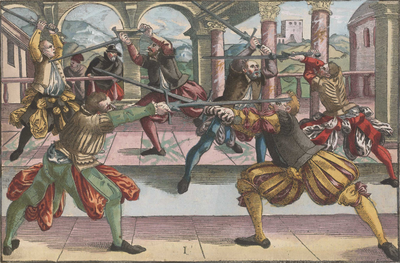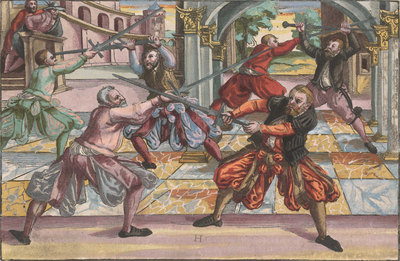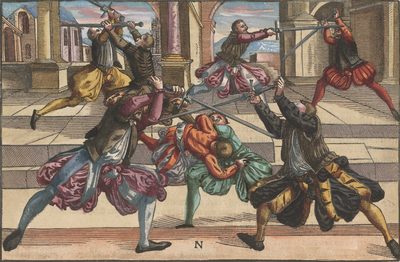|
|
You are not currently logged in. Are you accessing the unsecure (http) portal? Click here to switch to the secure portal. |
Difference between revisions of "Rosen"
Jump to navigation
Jump to search
m (2 revisions) |
|||
| Line 1: | Line 1: | ||
| − | + | {{master begin | |
| + | | title = Joachim Meyer | ||
| + | | width = 100% | ||
| + | }} | ||
| + | {{master subsection begin | ||
| + | | title = Sword | ||
| + | | width = 90em | ||
| + | }} | ||
| + | {| class="floated master" | ||
| + | |- | ||
| + | ! <p>Images</p> | ||
| + | ! <p>{{rating|C|Draft Translation (from the 1570)}}<br/>by [[Mike Rasmusson]]</p> | ||
| + | ! <p>[[Gründtliche Beschreibung der Kunst des Fechtens (Joachim Meyer)|1570 Transcription]]{{edit index|Gründtliche Beschreibung der Kunst des Fechtens (Joachim Meÿer) 1570.pdf}}</p> | ||
| − | + | |- | |
| + | | | ||
| + | | <p>'''Middle Guard'''</p> | ||
| + | |||
| + | <p>Concerning this Middle Guard you will be instructed later in the section on the dussack; as you do it there with one hand, so shall you do it here with both hands. I did not initially intend to present it here, but I have not been able to avoid it, since the Rose can be more fitly taught from no other guard. And note when an opponent comes before you who holds his sword extended before him in the Longpoint, or else in Straight Parrying, then send your blade in a circle around from the Middle Guard right around his blade, so that your blade comes almost back to your initial Middle Guard; from there swing the foible powerfully from outside over his arms at his head. Or when you have thus gone around his blade with the Rose, if he meanwhile should fall in down from above to your opening, then take his blade out with the short edge, that is when you have come for the second time in the Middle Guard; for he will not come so quickly as if by surprise to your opening, but that you will meanwhile come around with the Rose, such that you will come to take him out in plenty of time. And after you have thus taken him out, then let your weapon run around in the air over your head (in order to deceive him), looping for a Circle to the next opening, etc.</p> | ||
| + | |||
| + | | {{section|Page:Gründtliche Beschreibung der Kunst des Fechtens (Joachim Meÿer) 1570.pdf/101|1|lbl=1.40va}} | ||
| + | |||
| + | |- | ||
| + | | | ||
| + | | <p>Or in the Onset when you have cut into the Middle Guard on your left, and meanwhile your opponent cuts at you from above, then step well out from his cut toward his right side, and cast your short edge over or outside his right arm at his head; and as you cast in, let your blade shoot well in, either at his head or over his arms. Afterwards pull your sword quickly back up, and cut from your left with the long edge strongly upward at his right arm. From there, attack him further as you will, with such techniques as you will find above or below in this treatise. And since the Rose can also fitly be executed in the Longpoint, I will describe the rest of the devices that I intended to present with the Longpoint, thus:</p> | ||
| + | | {{section|Page:Gründtliche Beschreibung der Kunst des Fechtens (Joachim Meÿer) 1570.pdf/101|2|lbl=1.40vb}} | ||
| + | |||
| + | |- | ||
| + | | | ||
| + | | <p>'''Longpoint'''</p> | ||
| + | |||
| + | <p>The combat masters of old called Longpoint the ‘Break-Window’, because all other devices can be broken from it. Now although one can sufficiently deduce from the devices I have already taught what one shall execute from this posture, based on similar ones, I will show something about it through examples, since the Longpoint is the end of all binding.</p> | ||
| + | | {{section|Page:Gründtliche Beschreibung der Kunst des Fechtens (Joachim Meÿer) 1570.pdf/102|1|lbl=1.41ra}} | ||
| + | |||
| + | |- | ||
| + | | [[File:Meyer 1570 Longsword I.jpg|center|400px]] | ||
| + | | <p>In the Onset, bind on your opponent’s sword with the High Cut, and as soon as he goes back up again from your sword, then cut at his chin from below between his arms while they are going up. Concerning this device see the two small figures on the upper left in Image I.</p> | ||
| + | | {{section|Page:Gründtliche Beschreibung der Kunst des Fechtens (Joachim Meÿer) 1570.pdf/102|2|lbl=1.41rb}} | ||
| + | |||
| + | |- | ||
| + | | | ||
| + | | <p>Item: bind him as before, and as soon as the swords connect in the bind, then break through below with the Rose between you and him, and cast the short edge in at his head on the other side. Or after you have broken through below from the bind with the Rose, then wrench his sword sideways from the other side with the short edge, so that your hands cross over one another in the air; strike deep with the short edge over at his head.</p> | ||
| + | | {{section|Page:Gründtliche Beschreibung der Kunst des Fechtens (Joachim Meÿer) 1570.pdf/102|3|lbl=1.41rc}} | ||
| + | |||
| + | |- | ||
| + | | | ||
| + | | <p>Item: bind him against his incoming cut, and as soon as the blades connect, push your pommel through under your right arm, stepping at the same time well out toward his left side; and go up with crossed hands, and cut with the long edge through the Rose sideways from below behind his arm at his head.</p> | ||
| + | | {{section|Page:Gründtliche Beschreibung der Kunst des Fechtens (Joachim Meÿer) 1570.pdf/102|4|lbl=1.41rd}} | ||
| + | |||
| + | |- | ||
| + | | [[File:Meyer 1570 Longsword H.jpg|center|400px]] | ||
| + | | <p>Item: when you bind your opponent, then release your left hand from the pommel, and use it to grip his blade to yours in the bind, and do it quickly; then go through below with your right hand and the haft, and strike up toward your right, as you can see in the two small figures on the right in Image H; thus you take his sword away from him.</p> | ||
| + | | {{section|Page:Gründtliche Beschreibung der Kunst des Fechtens (Joachim Meÿer) 1570.pdf/102|5|lbl=1.41re}} | ||
| + | |||
| + | |- | ||
| + | | | ||
| + | | <p>Item: if your opponent binds you with extended sword on yours, then note when the binds connect together, and quickly change through below, and flick the little flat of the foible at his ear from the other side. From this changing through you will learn to do many fine devices, if you diligently study it.</p> | ||
| + | | {{section|Page:Gründtliche Beschreibung der Kunst des Fechtens (Joachim Meÿer) 1570.pdf/104|1|lbl=1.42ra}} | ||
| + | |||
| + | |- | ||
| + | | [[File:Meyer 1570 Longsword N.jpg|center|400px]] | ||
| + | | <p>Item: when you see that your opponent will bind or cut at you, then send your sword in against him, as if you also intended to bind, and just when the blades are about to connect, push your pommel up quickly, and turn your blade up from below through the Rose, catching his stroke on your long edge, as is shown in the small scene on the right in Image N. After you have thus caught his cut, you can finish this device in two ways. Firstly thus: when the swords have connected, then go right through below with your blade, and wrench his blade toward your right, and let your hands snap around in the air again, or cross over one another, and cut with the short edge strongly at his head. This is a masterful going through that will not fail you, if he should cut from above. For the second, when you have caught his sword, then as the swords clash together, step well to his left side, and cut back with the long edge from outside over his left arm at his head. This last cut proceeds unexpectedly, very swiftly, surely, and strongly.</p> | ||
| + | | {{section|Page:Gründtliche Beschreibung der Kunst des Fechtens (Joachim Meÿer) 1570.pdf/104|2|lbl=1.42rb}} | ||
| + | |||
| + | |} | ||
| + | {{master subsection end}} | ||
| + | |||
| + | {{master subsection begin | ||
| + | | title = Dussack | ||
| + | | width = 90em | ||
| + | }} | ||
| + | {| class="floated master" | ||
| + | |- | ||
| + | ! <p>Images</p> | ||
| + | ! <p>{{rating|C|Draft Translation (from the 1570)}}<br/>by [[Mike Rasmusson]]</p> | ||
| + | ! <p>[[Gründtliche Beschreibung der Kunst des Fechtens (Joachim Meyer)|1570 Transcription]]{{edit index|Gründtliche Beschreibung der Kunst des Fechtens (Joachim Meÿer) 1570.pdf}}</p> | ||
| + | |||
| + | |- | ||
| + | | | ||
| + | | <p>Now some cuts are not reversed in delivering them, and yet are named differently, and the reasons are these. The first is according to the intention of the one who delivers it, as happens with the Failing and Knocking Cut, which although they are High Cuts, yet they are so named because my intent is to miss with the one, with the other to knock against my opponent if I have an opening. And some names are based on the emotion of the mind, like the Wrath and Anger Cut. Also some receive their names from the shape they resemble in cutting, like the Rose Cut. Some are named for the limb at which they are delivered, as you will see in the section on the rapier in the Hand Cut and the like. On the basis of what I have now presented, you can now easily understand the cuts that are presented afterwards, and observe how much they are distinct from the chief cuts.</p> | ||
| + | | {{section|Page:Gründtliche Beschreibung der Kunst des Fechtens (Joachim Meÿer) 1570.pdf/168|1|lbl=2.9ra}} | ||
| + | |||
| + | |- | ||
| + | | | ||
| + | | <p>'''Rose Cut'''</p> | ||
| + | |||
| + | <p>If you find an opponent waiting in the Bow, then act as if you intended to cut from above at his head; do not let the cut connect, but go outside his right arm and through below, so that you come around in a circle around his dusack, and let it run off again in the air beside his right, and cut at his face. You may go around his parrying this way on the other side in a circle, and cut in where you find him open.</p> | ||
| + | | {{section|Page:Gründtliche Beschreibung der Kunst des Fechtens (Joachim Meÿer) 1570.pdf/172|3|lbl=2.11ra}} | ||
| + | |||
| + | |} | ||
| + | {{master subsection end}} | ||
| + | {{master end}} | ||
[[Category:Other Techniques]][[Category:German Techniques]] | [[Category:Other Techniques]][[Category:German Techniques]] | ||



